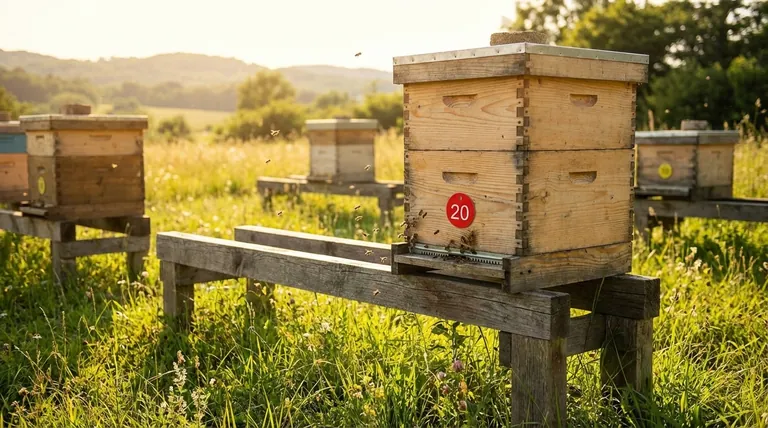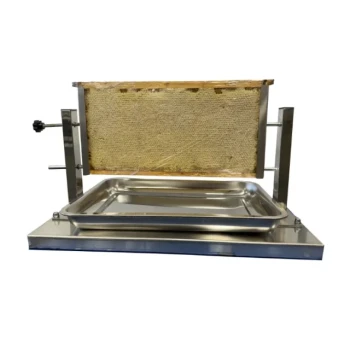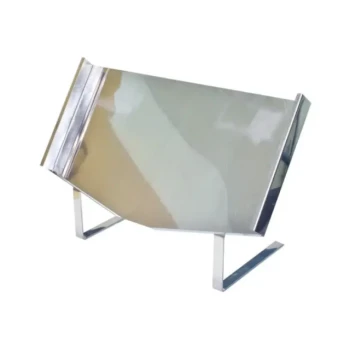In beekeeping, a hive stand is far more than just a piece of furniture for your hive. Its primary purpose is to elevate the beehive off the ground. This simple act provides critical benefits for the health of the colony by protecting it from moisture, pests, and temperature fluctuations, while also making hive management significantly easier and safer for the beekeeper.
While a hive's success is determined by the colony within, its long-term viability is heavily influenced by its immediate environment. A hive stand is a foundational tool that addresses two fundamental challenges at once: it enhances hive health and dramatically improves beekeeper ergonomics.

The Core Benefits of Elevation
A hive stand’s value comes from achieving one simple goal: getting the hive off the ground. This separation creates a buffer zone that solves several problems before they can begin.
Protecting the Hive and the Colony
A colony's health is directly tied to the condition of its home. A stand is the first line of defense against environmental threats.
It prevents moisture damage by keeping the wooden bottom board from having direct contact with damp ground. This reduces the risk of wood rot and helps keep the interior of the hive drier, inhibiting the growth of mold and moisture-related diseases.
Elevation also deters ground-dwelling pests. It creates a significant barrier for ants and other crawling insects, making it much harder for them to invade the hive. Placing the stand's legs in containers of oil or coating them with a slippery substance can further enhance this protection.
Finally, a stand keeps the hive entrance clear. It lifts the entrance above grass and weeds, ensuring the bees have an unobstructed flight path and preventing vegetation from blocking ventilation.
Improving Beekeeper Ergonomics and Safety
Beekeeping is a physically demanding activity, and a hive stand is a beekeeper's best friend.
The most significant benefit is the reduction of back strain. A standard hive can easily weigh over 100 pounds (45 kg) when full of honey. Lifting heavy hive boxes from a waist-high stand is exponentially easier and safer than bending over to ground level.
This improved accessibility makes hive inspections more manageable and enjoyable. When you aren't fighting physical discomfort, you can focus more effectively on the health and status of your colony.
Ensuring Foundational Stability
A beehive is a tall, narrow structure that becomes top-heavy when filled with honey.
A well-built hive stand provides a level and stable platform. This is crucial for preventing the hive from tipping over in strong winds or on uneven ground, ensuring the security of the colony and the integrity of the hive structure.
Understanding the Options and Trade-offs
The goal is elevation, but the method can vary. It is not necessary to buy a specific product labeled "hive stand" to achieve the benefits.
Commercial Stands vs. DIY Solutions
Many styles of hive stands are available for purchase, often with features like built-in frame holders. These are convenient but not required.
A highly effective and common alternative is using cinder blocks and sturdy lumber. This DIY approach is inexpensive and provides the same core benefits of elevation, stability, and moisture protection. The critical factor is that the platform is level and strong.
Common Pitfalls to Avoid
Simply getting the hive off the ground is not enough; it must be done correctly.
Avoid using a wobbly or unstable base, as this is more dangerous than having no stand at all. Ensure your stand is perfectly level and can support the full weight of a productive hive.
The height is also important. A stand that is too low (less than 6-8 inches) offers minimal protection, while one that is too high can make it difficult to lift heavy honey supers onto the top of the hive. A height of around 18 inches is a common ergonomic sweet spot.
If using cinder blocks, be aware that their hollow cores can become homes for pests like ants or mice. It is wise to orient the blocks so the holes are not accessible or to fill them.
Making the Right Choice for Your Apiary
Your choice of hive stand should align with your specific goals, budget, and physical needs.
- If your primary focus is hive health: Elevate your hive at least 8-12 inches to ensure adequate protection from ground moisture and common pests.
- If your primary focus is beekeeper comfort: Position the hive so the bottom box is at a comfortable working height, typically 16-20 inches, to minimize back strain.
- If your primary focus is budget and simplicity: Use a stable configuration of cinder blocks and sturdy lumber, which provides all the core benefits without the cost of a commercial stand.
Ultimately, elevating your hive is one of the simplest and most effective actions you can take to foster a thriving colony and a more sustainable beekeeping practice.
Summary Table:
| Benefit | Key Takeaway |
|---|---|
| Hive Health | Elevates hive to prevent moisture damage, wood rot, and deter ground pests like ants. |
| Beekeeper Ergonomics | Reduces back strain by lifting the hive to a comfortable working height. |
| Stability & Safety | Provides a level, stable platform to prevent the hive from tipping over. |
| Ventilation | Keeps the entrance clear of grass and weeds for an unobstructed bee flight path. |
Ready to build a stronger foundation for your apiary?
A hive stand is a simple upgrade with a major impact on your colony's health and your own comfort. At HONESTBEE, we supply durable, wholesale-focused beekeeping supplies and equipment to commercial apiaries and distributors.
We can help you find the right solution—from commercial stands to materials for a robust DIY setup—to ensure your hives are protected, stable, and easy to manage.
Contact our team today to discuss your apiary's needs and explore our wholesale options.
Visual Guide

Related Products
- Professional Engraved Round Hive Number Tags for Beekeeping
- Metal Bee Hive Stand Bee Box Stand for Beekeeping
- Plastic Bee Hive Stand for Beekeeping
- Professional Drop-Style Hive Handles for Beekeeping
- Wholesales Dadant Size Wooden Bee Hives for Beekeeping
People Also Ask
- How can hive stands be made more secure in windy areas? Anchor Your Apiary Against the Elements
- How should a Posca pen be prepared for queen marking? Ensure a Safe, Precise Mark Every Time
- What is the best height for a hive stand? Optimize for Pest Control and Beekeeper Ergonomics
- Why is it recommended to buy at least two bee hives? Boost Your Success with a Second Colony
- What are the characteristics of Posca pens for marking queens? A Safe, Durable Solution for Hive Management



















